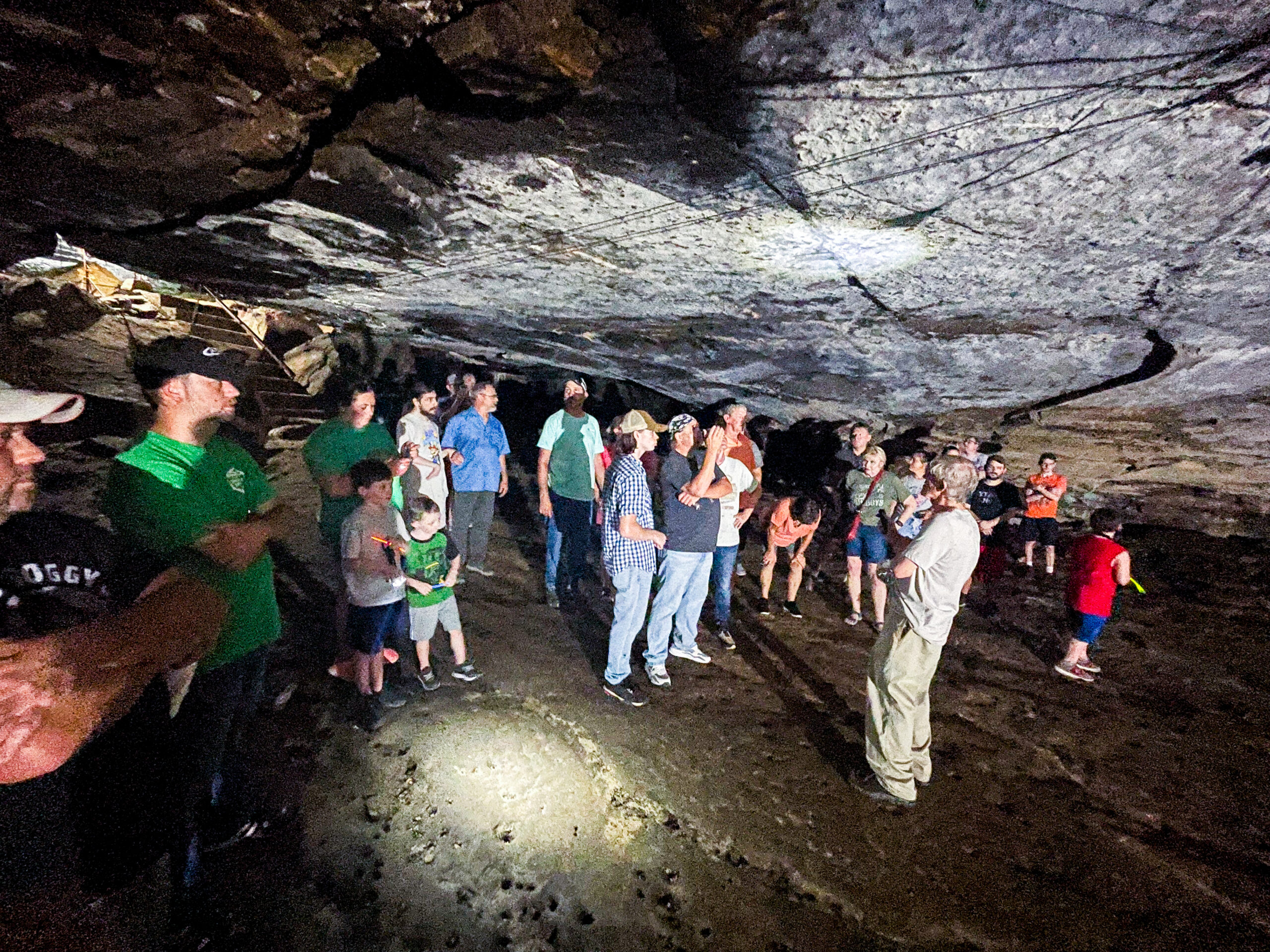Tammy Curtis, Managing Editor
It served as an early home and burial area for Osage Indians and later a community refrigerator, but the iconic one of a kind rock structure above Cave City’s namesake cave has evolved over the years and today is on the National Historic Registry, but remains privately owned.
Last week for the first time in nearly 20 years, the owners, Dan and Irma Carrington, of what most simply call “the Cave” in Cave City opened their cave for public tours during Watermelon Festival.
When “Caveman Dan,” as he is affectionately called locally, and his wife, Irma bought the property that houses the cave and old motor court, they likely just thought they bought a unique property, but the history and future would be something they would become part of for decades.
While many do not even know there is a cave in Cave City or never stopped to think of why the city bears that name, they do often wonder what the strange looking rock structures in the heart of the town were in their heyday. Long before Cave City was named Cave City in the mid 1930s, the town was called Loyal. One man would change that with his brainstorm to draw tourists to the area.
What is a Tourist Camp?
Crystal River Tourist Camp or Crystal River Cave and Court as it became known in the early 1930s was the beacon that welcomed visitors to the city and allowed them to enjoy its finest accommodations for the time.
In the 1970s, after closing in the 1950s and being remodeled it was given a fresh name… The Cave Court Modern. It sits atop the massive cave and subterranean river known as the Crystal River.
The property, which was largely known to have been a home to Osage Indians, was purchased by Cave City native Hubert Clarence Carpenter in 1932 to build a tourist camp.
Tourist and motor port camps were a very common form of lodging in the U.S. from the 1930s through 60s. Camps of this type usually contained several cottages or cabins, much like hotels but offered more amenities, like pre Airbnb type of accommodations for travelers. The Camp would actually put Cave City on the map along with their famous sweet watermelons.
What was it before it was a tourist camp?
In the early 1800s the cave was widely known as Horn’s Cave after the owners of the land above. It was later purchased by Dr. G.T. Laman before Carpenter purchased it in 1934 for development.
Why was it built?
The property surrounding the mouth of the cave was a prime location for gatherings and tourists to experience the city along one of the most traveled routes in the state. The cave and rocks near its entrance were not only a scenic backdrop, but also provided cooler temperatures. The area served as the city park, or many years until the current park was formed and the Cave City Watermelon Festivals used to be held there. Students at Cave City High School have had their senior group picture taken in front of the cave for decades. One lady on the tour recalled having them done in 1979.
How did they build it?
Carpenter’s idea was to build cabins from the inspiration of a Swedish village while incorporating his Christian faith and respect for the Native Americans into its construction.
One of the first things the eyes of anyone passing through town witnesses is the uniqueness of the rock buildings, strange rooflines and the reality that the structures are a piece of history that has largely stood the test of time.
Carpenter owned H.C. Carpenter Store, was a teacher, mail carrier, mason and commanded the local VFW. He commissioned another mason to build the unique camp. Prince Matlock not only loved to explore caves, but was also a carpenter and stone mason and began a project so labor intensive, that it would take ten years to complete.
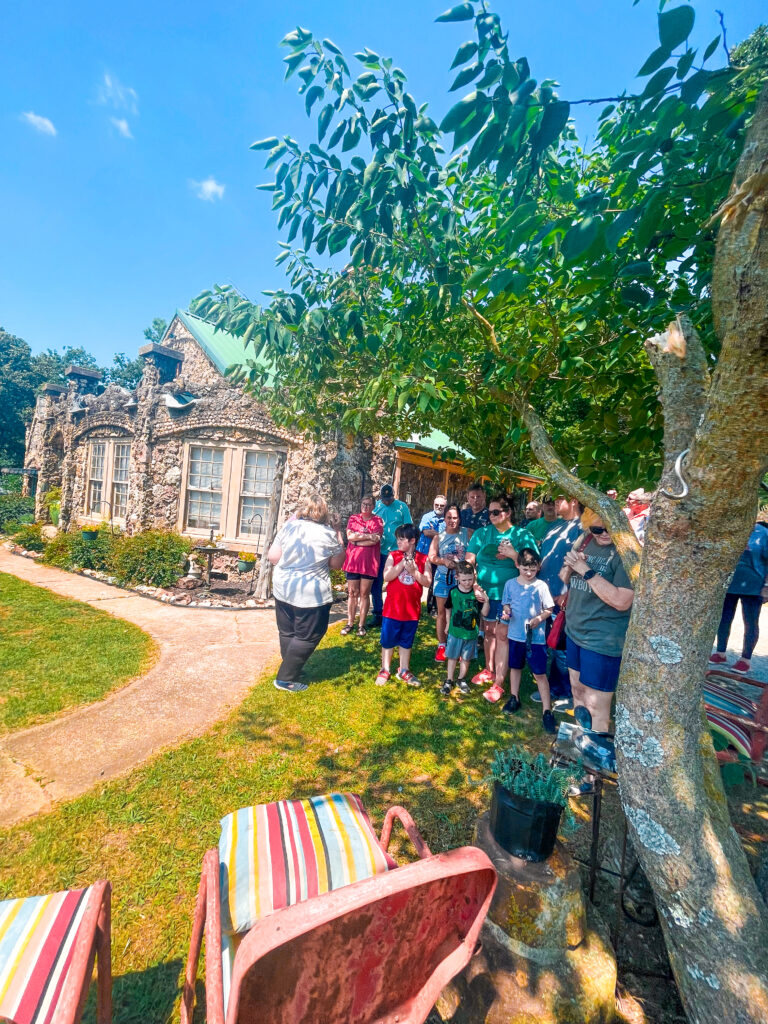
Irma explains the unique features of the home and cottages.
What did they include in the construction?
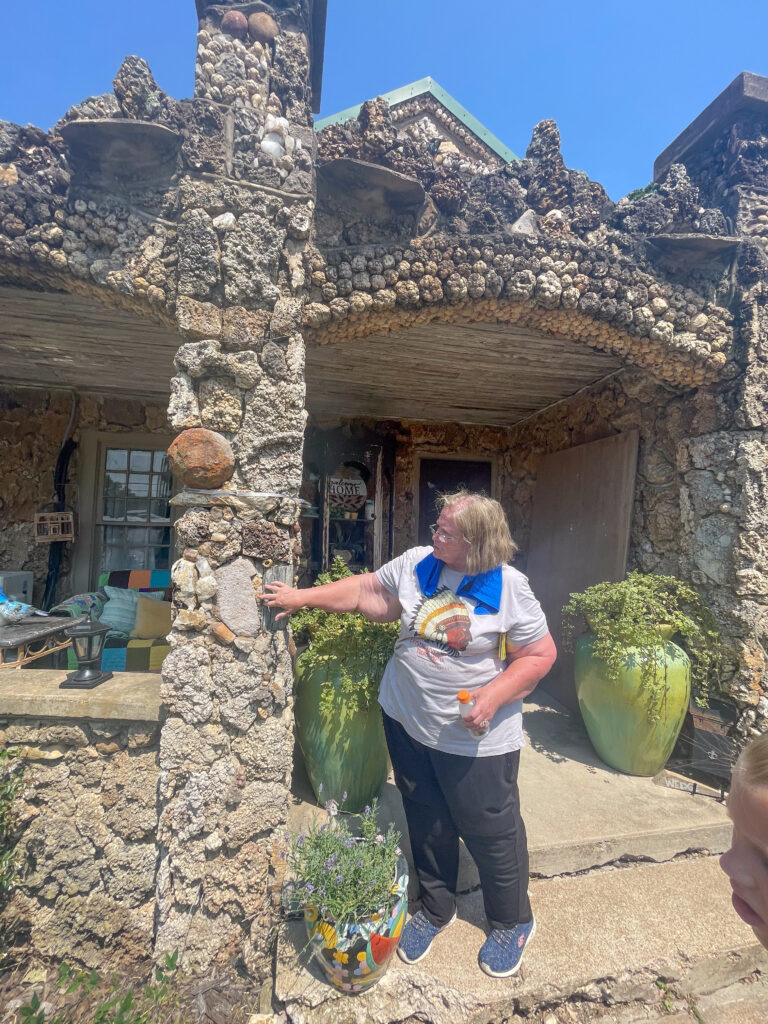
The majority of the thousands of geodes the cover many of the outlines, surface and arches of the home were purchased from a farmer in nearby Calamine at the cost of 50 cents for a 15 gallon wash tub, according to historical written records. Local fieldstone was also nused in the exterior.
The geodes were removed from a rock wall on the farmer’s property that was constructed by Native Americans. Irma explained the unique main house is one of only homes in the nation, and likely the world, that’s exterior is covered nearly exclusively with various types of quartz.
A close up view of the various rocks and geodes covering the home.
Matlock also embedded crystals, petrified wood, and Indian relics, among them, bone chips and arrowheads, into the walls of the building that has been home to the Carrigan’s since 1997. They were also included in the five residential cottages, some of which are individual and some conjoined. Matlock also built a pump house, and cave entrance structure using the same methodology incorporating various quartz and other rocks.
The back of the home is also unique and incorporated Carpenter and his wife, Eunice’s, love of music. Both arched entries at the back are shaped like upside down tuning forks. The side porch of the home continues Carpenter’s love of Native American history with a large fertility symbol of Osage Indians embedded into the wall made from various types of geodes and crystals. All the squares on the home’s corners contain various stones. Rocks on the home have come from every state in the United States.
Irma explained on the tour that when she and her husband did some repairs to one of the rooms in the home that had a very thick concrete interior.
Also incorporated into the homes design are rocks formed into the structure with three crosses, each symbolizing. The Trinity. With pink and clear quartz construction, the crosses symbolize the virtue of Purity and love.
Perhaps one of the most unique of these examples is a rock incorporated into the home’s interior that looks like a petrified face. The rock was found outside the mouth of the cave and is one of the only type found in the world, according to Irma. The Smithsonian Institute has expressed an interest in the one on the home. She said they have received inquiries about the rock from both National Geographic and 48 hours. She explained they believe the sandstone rock has been carved out of sandstone by the Indians, and isn’t actually a skull.
Motor court buildings
The five buildings that make up the motor court with a circular type courtyard in the center had variety of options for tourists including original carports. Irma said the narrow carports were to fit Model A cars in and the much wider vehicles of latter years would never fit.
Also included within the construction of the motor court buildings was low-walled patios, barbecues pits, fireplaces, and a loading dock. In addition to the eight buildings are numerous landscape features also built by Matlock, including rock walls, fences, retaining walls, arched gateways, birdbaths, steps, paths, and stoops. Four of the original buildings have gabled roofs, and four have flat roofs with graduated openings Matlock formed using stones embedded in concrete and placed upright. The narrow fieldstones give the home the staggering “dinosaur back” appearance Irma mentioned.
Are the Osage still protecting the area?
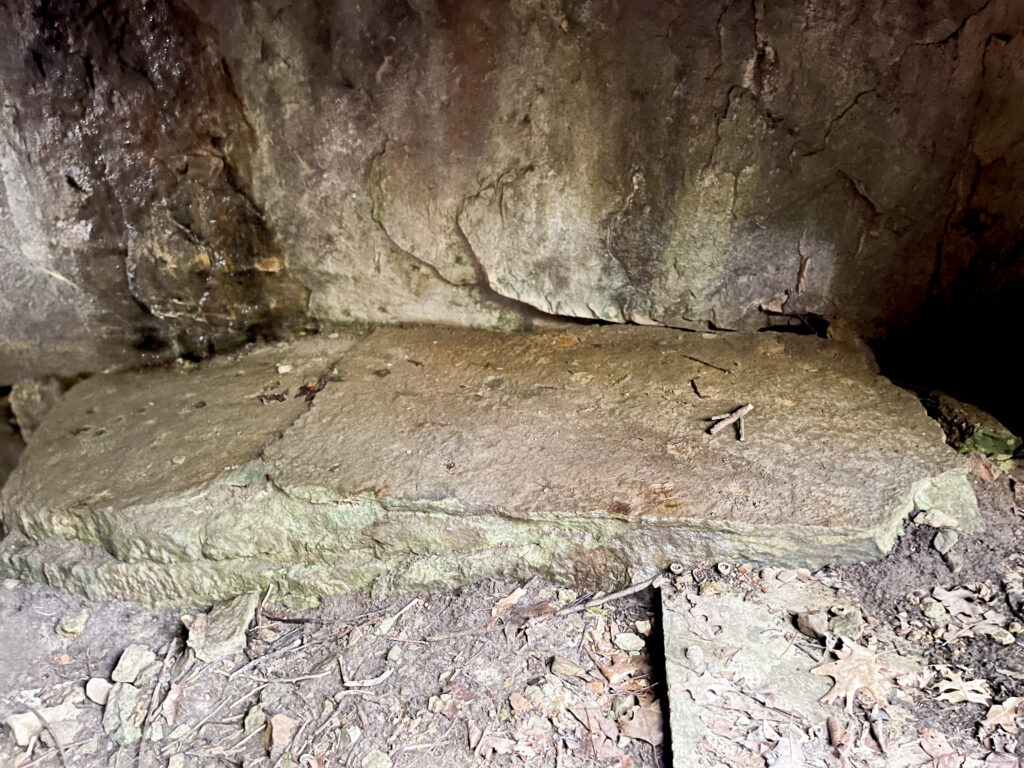
The tomb of who was believed to be one of the Osage Chiefs who lived in the cave.
Hints of presence of Osage Indians can be witnessed around the home, property and cave, as if protecting it from the Great Beyond against the evils of time.
One of the walls of the home contains protruding reliefs depicting flaming torches signifying the Osage’s means of visibility within the cave.
Upon entering the cave, a massive rock formation greets visitors. It has been told for generations that the rock depicts an Indian looking upward with eyes, a nose and face, as to be a looking upward to protect the tribe and perhaps visitors to the cave.
The cave runs under Highway 167 near Hometown Market grocery store. The cave portion of the tour was conducted by Dan. As visitors enter the cave they walk through a gallery of sorts with Native American items. Years before the Carrigans purchased the property, the previous owners had actual skeletal remains of Indians within the display. This was hugely frowned upon and sacrilege. The remains were eventually stolen by vandals.
The Osage Indians, known to inhabit the area were among the tallest in North American at between six to seven foot tall. The Indians were largely peaceful but liked to scare adversarial tribes. To the left of the entrance is what is believed to be the tomb of one of the tribe’s chiefs as artifacts consistent with a chief were found near the tomb. The large flat stone that is believed to house the body is distinctly smoother and darker than other stones and shaped in a near perfect rectangle around 7 feet long.
Dan explained it was believed that the tribe were attacked by another tribe or settlers and some of their tribe were killed and buried within the burial chamber found in the cave. The burial chamber remains but is undisturbed. He said when he first moved into the home people had attempted to gain entrance to the tomb and dug around for more artifacts. The evidence of the attempt is markings on the stone.
Etchings on the cave’s wall of a lions head, buffalo and man sitting on a horse are further evidence the Native Americans inhabited the cave.
Let’s go below
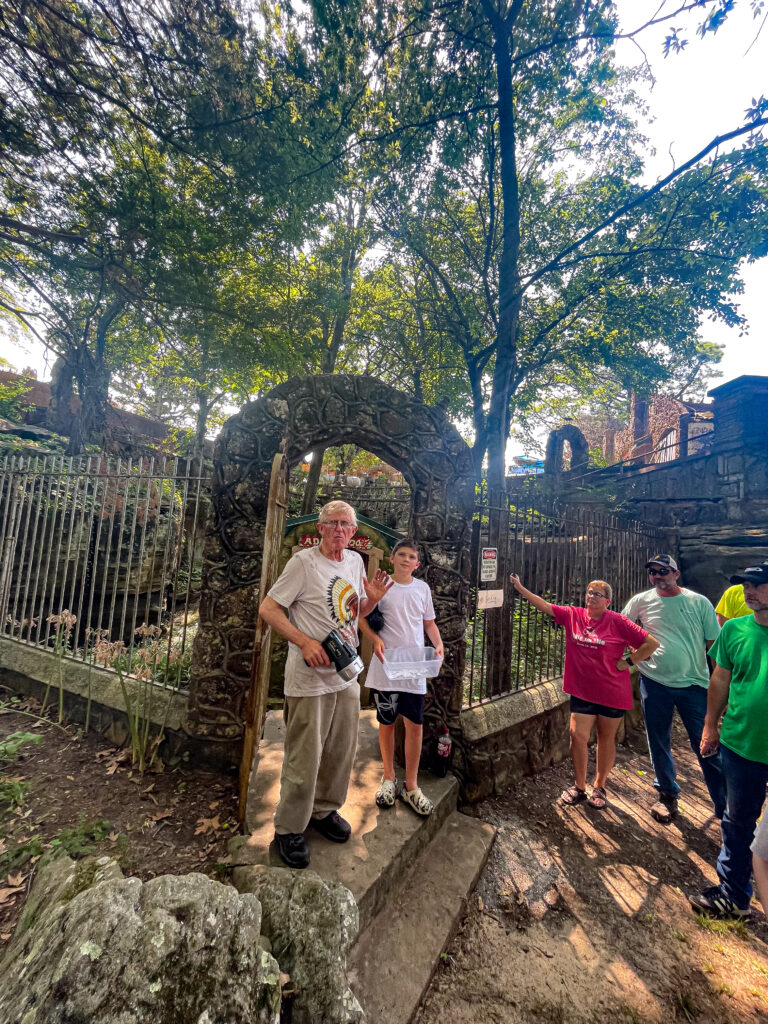
After walking into the first narrow room of the at least five known rooms that comprise the cave, Carpenter made certain visitors knew of his faith. The first set of three steps down represent the Trinity, the Father, the Son and The Holy Ghost. This is the room where the Indians would have first made entrance to the cave below, sliding down about 12 feet to the main room, that along with the rest of the cave, stays at 57 degrees year round. Because the cave is a sandstone cave, not a limestone one that forms stalagmites and stalactites then cave’s moisture and drips erase the sand below creating varying sized holes through the years.
Caveman Dan prepares the tour group to go below the surface into the cave.
In the early days of the tourist camp, the cave was used as a community refrigerator. Back in those days, ice was expensive and families would bring their perishables to the cave. Dan said the children would then retrieve their families provisions. “All the kids new whose box was whose by the colored ribbons on them,” he explained.
Within the large room that measures 80 feet wide and about 10 feet tall. Within this room is also the fault line. Dan explained caves have natural fault lines to provide them space to expand and contract. The Crystal River Cave has a unique rock between the massive deep fault line on the ceiling. Dan called it a thinking rock. “You stand under that rock and think, ‘I don’t think I want to stand here that long,’” he said laughing.
Years before many homes in the area had benefit of electricity, Carpenter saw it fitting to equip his jewel of a tourist camp’s cave with power. The crude fixtures and conductors are still strung along the roof of the cave but more modern portable lighting provides a much brighter view of the cave.
The Crystal River
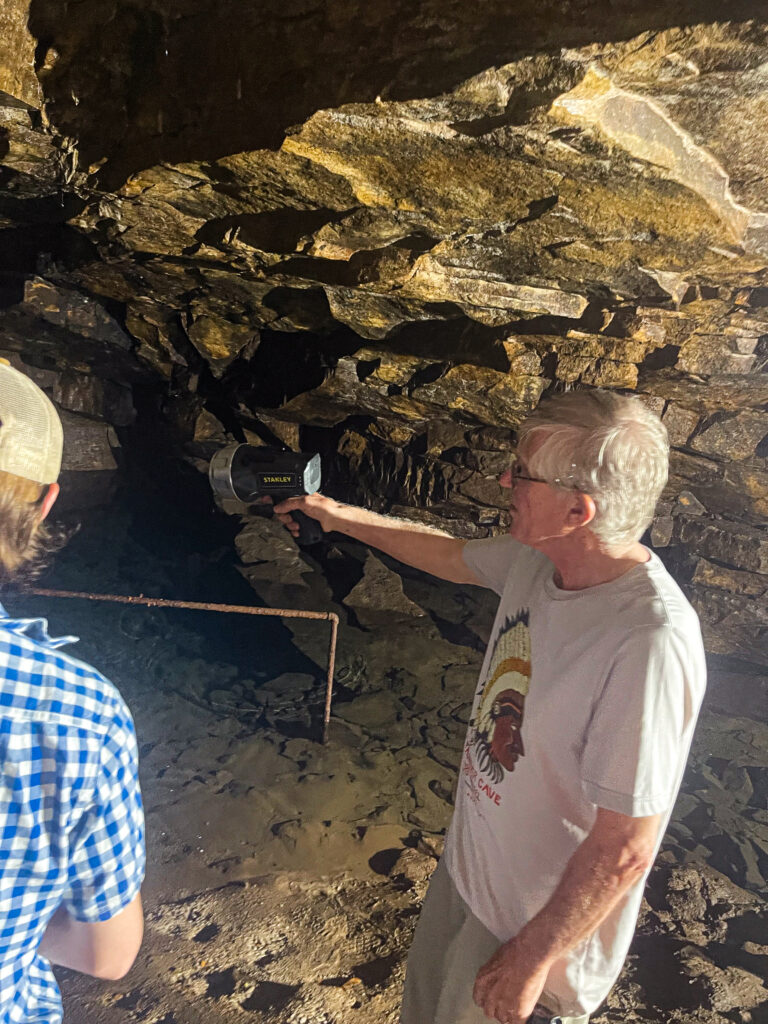
From the second room, Carpenter equipped the cave with handrails to make the ascent down to the room below where the river begins easier. Seven steps were made in a place they really weren’t required but represented the perfect number seven in the Bible that symbolizes completion. This was the last part of the cave visible.
Protected from weather and their enemies, the Crystal River Cave was also an excellent water source for the Indians.
Visitors eyes are instantly drown to the deep blue of the river as they descend down toward the cave’s namesake. A separate set of very steep handrails that are currently under what looks like 3-5 foot of water are actually 20 feet below the surface, further demonstrating the clarity of the river. It is unknown where the river begins or ends. It is known to rise and fall with the Mississippi River through the years. During the Winter and early Spring months the water within the cave is higher than in the dryer seasons.
Also visible are two large pipes coming from ground level. Dan explained the until the 1970s the city of Cave City had ample water supply for its residents. When the supply was getting low, the city dug deeper to increase the supply. This caused the cave to flood.
A man stopped to visit before the tour group went below and told them that Nels Lamon went back two miles into a cave in a boat with a rope in the early years before it was flooded by the drilling.
Dan explained divers have went back much further back than the area of the river that is visible and saw an opening but had to come back due to the danger or underwater diving. It is a widely shared belief that passable portion is only a small part of a much larger cave network.
Critters below
While caves seem to be lifeless, several species live and thrive within the cave. Cave crickets, eyeless sucker fish and a species that was discovered by scientists in the cave in 2002.
The species of freshwater shrimp as given the scientific name Bacturus speleopolis, the second word being Greek for Cave City. So watermelon, a cave and a shrimp that is protected and can’t be boiled for a weekend get-together are the city’s claims to fame.
National Register of Historic Places
While the Crystal River Tourist Camp’s original mission was to draw tourism to share the area, the camp and cave have been privately owned since closing in the 50s. It has been opened several times but never full time or with the original purpose.
The Carrigans take pride in their cave and home and Irma said she has no plans of selling the property, despite having been asked multiple times. Various community leaders and civic and tourism related organizations have expressed an interest in purchasing and renovating the property with the help of grants to open the unique camp to the public as a remarkable way to tell the history of the city. Irma said if something ever happens to her husband she might be forced to sell out but plans to keep it private.
She said they have considered opening up a portion of the park in front of the cave entrance for recreational vehicles. She said they have thought seriously about also allowing tent camping during the eclipse at the park.
The camp and cave were placed on the National Register of Historic Places in 1991 as was a large gum tree near the cave’s entrance. The Crystal River Tourist Camp is the oldest motor court in the state.
Several books have devoted chapters to the history of the structure and cave. Off the Beaten Path, Let Us Build us a City and the Beast of Bogey Creek are just a few.
The Carrigan’s said they plan to offer more tours and will make the information available when dates are set.

